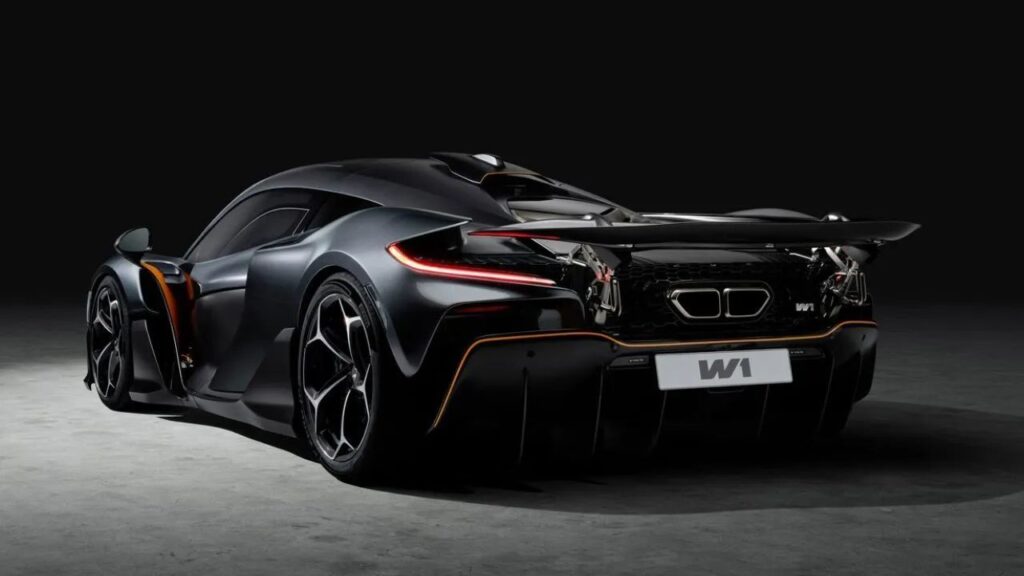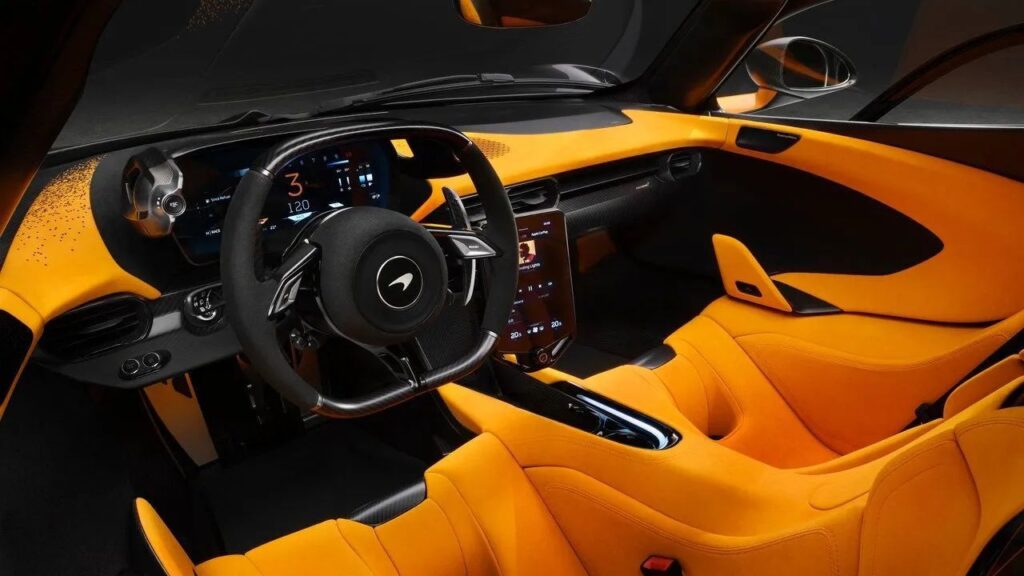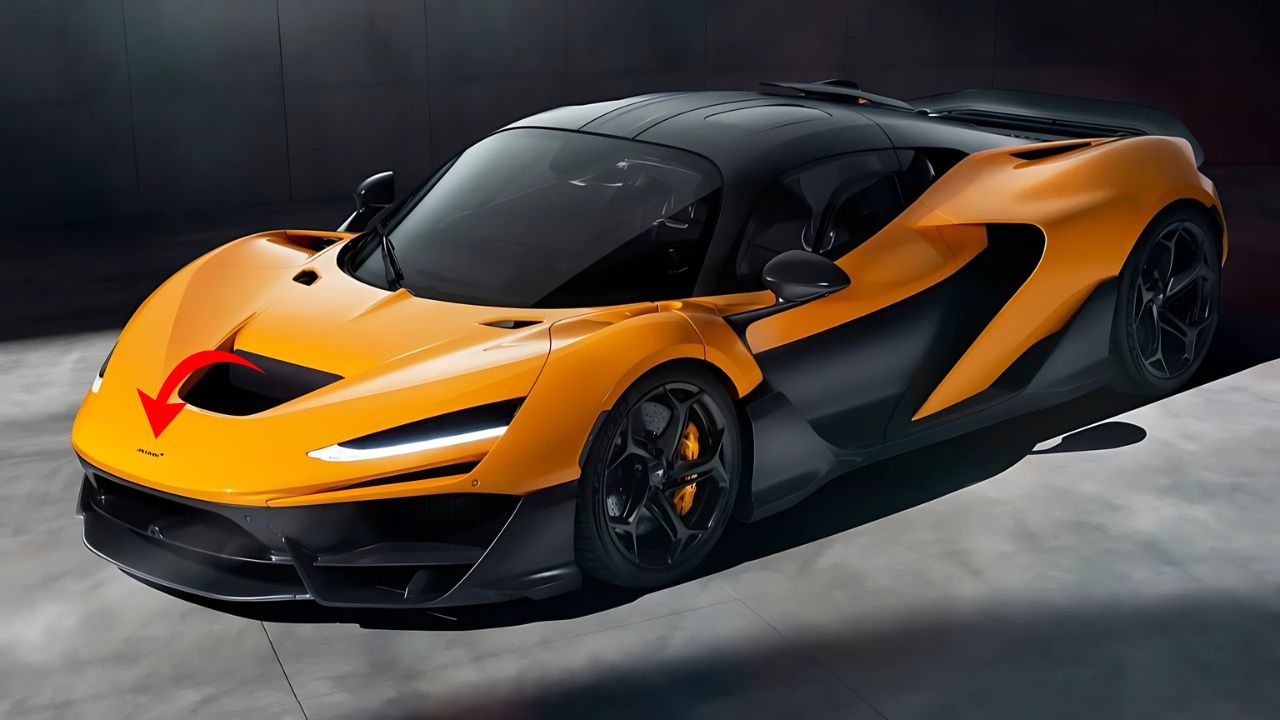McLaren has unveiled its most powerful road car ever created. The W1 hybrid hypercar represents the absolute pinnacle of McLaren’s engineering capabilities, combining Formula 1 technology with road car practicality.
With 938kW of combined power output, the W1 establishes new benchmarks for performance and technological sophistication. This isn’t just another fast car – it’s a rolling demonstration of what becomes possible when engineering constraints are removed.

The Ultimate McLaren: W1 Development Story
McLaren’s approach to the W1 began with a simple question: what would the ultimate McLaren look like? Every component, every system, every detail received consideration through this lens.
Development took place alongside McLaren’s Formula 1 program. Technology transfer between racing and road cars reached unprecedented levels, with active systems and materials science sharing common development paths.
Design Philosophy and Aerodynamic Excellence
Form follows function dominates the W1’s design language. Every surface serves aerodynamic or cooling purposes, creating sculpture that happens to be devastatingly effective.
Active aerodynamics respond to driving conditions. The W1’s bodywork literally reshapes itself to optimize downforce, drag, or cooling depending on immediate requirements.
Carbon fiber construction extends beyond just body panels. The entire structure utilizes advanced composites, creating exceptional strength while maintaining minimal weight.
Wind tunnel development consumed thousands of hours. CFD analysis and physical testing refined every aerodynamic element to achieve maximum efficiency.
Hybrid Powertrain Integration
The 938kW power figure comes from sophisticated hybrid system integration. Internal combustion and electric power work together seamlessly, creating performance that exceeds either system alone.
McLaren’s hybrid philosophy emphasizes performance over efficiency. While environmental benefits exist, the primary goal remains delivering the ultimate driving experience.
Battery technology optimizes power delivery rather than range. Quick bursts of maximum performance take priority over extended electric-only operation.
Thermal management systems handle enormous heat loads. Cooling requirements for 938kW output demanded innovative solutions across multiple vehicle systems.
Powertrain Technology and Performance
The W1’s powertrain represents McLaren’s current understanding of maximum performance. Combining twin-turbocharged V8 combustion with electric assistance creates truly extraordinary capabilities.
Peak power output occurs across a broad rev range. Unlike purely combustion powertrains, the hybrid system fills torque gaps and extends the effective power band.
Internal Combustion Engine Specifications
McLaren’s twin-turbo V8 provides the foundation. Extensive development specifically for hybrid application optimized power delivery and thermal efficiency.
Turbocharging systems use advanced materials and design. Variable geometry turbines and sophisticated boost control ensure optimal response across all conditions.
Fuel system specifications handle extreme demands. High-pressure injection and racing-derived fuel delivery ensure consistent performance under maximum load.
Engine management integrates seamlessly with hybrid control. Sophisticated algorithms coordinate combustion and electric power for optimal performance and efficiency.
Electric Motor Integration and Control
Electric motors provide instant torque delivery. Strategic placement and advanced control systems enhance both performance and handling characteristics.
Battery systems prioritize power density over capacity. Quick discharge rates enable maximum performance bursts while maintaining acceptable weight.
Regenerative systems capture energy efficiently. Braking and deceleration events help maintain battery charge for subsequent acceleration phases.
Cooling systems handle electric component heat loads. Advanced thermal management ensures consistent performance during extended high-performance driving.
Chassis Engineering and Dynamics
The W1’s chassis represents McLaren’s most advanced road car platform. Carbon fiber construction and active systems create handling capabilities that approach racing car levels.
Suspension systems combine ultimate performance with reasonable road usability. Advanced dampers and springs provide control without compromising everyday drivability completely.
Active Suspension and Handling Systems
Adaptive dampers respond in milliseconds. Sensor inputs and predictive algorithms adjust suspension settings faster than human perception.
Anti-roll systems actively manage body movement. Electronic control prevents excessive lean while maintaining compliance over surface irregularities.
Ride height adjustment optimizes aerodynamics. The W1 can lower itself for maximum downforce or raise for improved ground clearance.
Wheel and tire specifications prioritize maximum grip. Custom-developed rubber compounds and wheel designs optimize contact patch and heat dissipation.
Braking Systems and Performance
Carbon-ceramic brakes handle enormous stopping requirements. Advanced disc materials and cooling designs ensure consistent performance during track use.
Brake-by-wire systems integrate with hybrid regeneration. Seamless blending between regenerative and friction braking maintains natural pedal feel.
ABS and stability systems allow maximum performance. Advanced algorithms permit controlled sliding while preventing dangerous loss of control.
Heat management prevents brake fade. Extensive cooling ducts and thermal barriers maintain consistent performance during extended track sessions.
Aerodynamics and Active Systems
The W1’s aerodynamic systems represent current state-of-the-art technology. Active elements constantly optimize the vehicle’s interaction with airflow.
Downforce generation reaches extraordinary levels. At speed, the W1 generates more downforce than its own weight, enabling cornering forces that defy normal road car expectations.
Active Aerodynamic Elements
Front splitter systems adjust to conditions. Variable geometry elements optimize downforce while managing drag and cooling requirements.
Rear wing configurations change automatically. Multiple positions provide different combinations of downforce and drag depending on driving requirements.
Underbody aerodynamics contribute significantly. Sophisticated diffuser systems and floor designs generate substantial downforce without external visibility.
Cooling airflow receives active management. Ducts and vents open and close to balance thermal requirements with aerodynamic optimization.
Computational Fluid Dynamics and Testing
CFD development involved millions of computational hours. Advanced modeling techniques optimized every aerodynamic surface for maximum effectiveness.
Wind tunnel testing validated computational results. Physical testing confirmed CFD predictions while identifying areas for further refinement.
Track testing provided real-world verification. Professional drivers evaluated aerodynamic performance under actual racing conditions.
Continuous development refines performance further. Ongoing CFD work and testing continue improving the W1’s aerodynamic effectiveness.
Interior Design and Technology Integration
Despite its performance focus, the W1 provides a sophisticated interior experience. Premium materials and advanced technology create an environment worthy of the mechanical excellence.
Driver-focused design prioritizes essential information. Everything needed for maximum performance remains easily accessible, while distractions are minimized or eliminated.
Cockpit Layout and Ergonomics
Seating positions optimize driver control. Racing-derived seat designs provide support during high g-force maneuvering while maintaining reasonable comfort.
Control placement follows racing car principles. Critical switches and adjustments fall naturally to hand without requiring visual confirmation.
Display systems provide comprehensive information. Multiple screens present telemetry data, performance metrics, and vehicle status information clearly.
Steering wheel integration includes essential controls. Paddle shifters, driving mode selectors, and communication systems remain immediately accessible.
Premium Materials and Craftsmanship
Carbon fiber elements extend throughout the cabin. Exposed weave patterns and premium finishes emphasize the W1’s technical sophistication.
Leather and Alcantara provide appropriate luxury. Premium materials balance performance requirements with the comfort expectations of hypercar buyers.
Metal accents use aerospace-grade materials. Titanium and billet aluminum components provide both functional and aesthetic excellence.
Custom options allow personalization. Buyers can specify colors, materials, and finishes to create truly individual vehicles.
Manufacturing and Production
W1 production takes place at McLaren’s specialized facility. Hand-built construction ensures attention to detail that mass production cannot match.
Limited production numbers maintain exclusivity. Each vehicle receives individual attention throughout the manufacturing process.
Assembly Process and Quality Control
Craftsmen assemble each W1 individually. Skilled technicians handle complex systems integration and final quality verification.
Testing procedures validate every system. Each vehicle undergoes comprehensive performance and safety testing before delivery.
Quality control standards exceed automotive norms. Aerospace-level precision ensures consistent excellence across all production units.
Delivery preparation includes customer orientation. New owners receive comprehensive instruction on the vehicle’s capabilities and systems.
Production Timeline and Availability
Manufacturing capacity limits annual production. McLaren maintains exclusivity while ensuring reasonable delivery timeframes for confirmed orders.
Order books typically extend years into the future. High demand and limited production create substantial waiting periods for new customers.
Specification choices affect delivery timing. Standard configurations may be available sooner than heavily customized variants.
Global distribution prioritizes key markets. Major automotive markets receive priority allocation, though availability remains extremely limited everywhere.
Market Positioning and Competition
The W1 competes in the ultimate hypercar segment. Rivals include Bugatti, Koenigsegg, and Pagani – manufacturers focused on absolute performance rather than mass market appeal.
Pricing reflects the extreme engineering involved. Development costs and limited production numbers necessitate prices that exceed most buyers’ capabilities.
Competitive Analysis and Differentiation
Each hypercar manufacturer brings unique approaches. McLaren’s Formula 1 connection provides genuine racing technology transfer unavailable elsewhere.
Performance comparisons become academic at these levels. All hypercar manufacturers achieve performance that exceeds real-world usability limits.
Brand positioning emphasizes McLaren’s racing heritage. Formula 1 success provides credibility that newer manufacturers cannot match immediately.
Technology leadership varies across different areas. Some competitors excel in raw power, others in luxury, while McLaren focuses on overall performance integration.
Target Demographics and Customer Profile
Hypercar buyers represent extremely wealthy individuals. Purchase decisions often prioritize exclusivity and emotional appeal over rational analysis.
Collector interest drives significant demand. Many buyers acquire hypercars for investment and collection purposes rather than regular driving.
Track day enthusiasts appreciate McLaren’s focus. The W1’s capabilities suit serious performance driving better than pure luxury alternatives.
Brand loyalty influences purchase decisions. Existing McLaren owners often graduate to flagship models as their ultimate expression of the brand.
Technology Transfer and Innovation
Formula 1 development directly benefits W1 engineering. Active suspension, aerodynamics, and materials technology flow from racing to road applications.
Hybrid system development advances automotive technology. Innovations pioneered in the W1 eventually influence more accessible McLaren models.
Formula 1 Technology Integration
Active suspension systems adapt racing technology. Sophisticated control algorithms and ultra-responsive dampers provide racing car control characteristics.
Aerodynamic knowledge transfers directly. Wind tunnel techniques and CFD expertise developed for F1 optimize the W1’s aerodynamic performance.
Materials science benefits from racing development. Carbon fiber advances and manufacturing techniques improve through continuous F1 development.
Data acquisition systems provide comprehensive telemetry. Racing-derived logging and analysis capabilities help owners understand and improve their driving.
Future Technology Development
Hybrid system advances continue evolving. Battery technology and motor development benefit from ongoing F1 hybrid system evolution.
Autonomous features may eventually appear. While current focus remains on driver engagement, future safety and convenience systems will likely incorporate advanced automation.
Connectivity improvements enhance ownership experience. Over-the-air updates and remote diagnostics provide ongoing support and enhancement capabilities.
Environmental Considerations
Despite its performance focus, the W1 incorporates environmental considerations. Hybrid technology provides efficiency benefits while enabling maximum performance.
Manufacturing processes emphasize sustainability. McLaren has implemented environmental management systems throughout production operations.
Hybrid Technology Benefits
Fuel efficiency improves despite increased performance. Hybrid assistance allows smaller displacement engines while maintaining power output.
Emissions compliance meets global standards. Advanced emissions control systems ensure regulatory compliance across international markets.
Electric assistance reduces local emissions. Pure electric operation becomes possible for low-speed or noise-sensitive environments.
Regenerative braking recovers energy efficiently. Deceleration events help maintain battery charge while reducing brake wear.
Sustainable Manufacturing Practices
Carbon fiber recycling programs minimize waste. Advanced recycling techniques recover valuable materials from production waste streams.
Energy efficiency improvements reduce environmental impact. Manufacturing facilities incorporate renewable energy sources and efficiency improvements.
Supply chain sustainability extends environmental benefits. Component suppliers must meet environmental standards that exceed minimum regulatory requirements.
Ownership Experience and Support
W1 ownership extends far beyond simple vehicle purchase. McLaren provides comprehensive support programs that match the vehicle’s exceptional nature.
Exclusive events allow owners to explore capabilities. Track days and driving experiences help owners safely experience their vehicle’s performance potential.
Customer Support and Service
Specialized service technicians receive extensive training. Complex hybrid systems and exotic materials require expertise beyond normal automotive service.
Parts availability receives priority attention. Critical components maintain inventory levels that minimize service delays for W1 owners.
Mobile service capabilities bring support to owners. Technical specialists can provide on-site service for routine maintenance and minor repairs.
Warranty coverage provides comprehensive protection. Extended warranty options protect against the high costs associated with hypercar ownership.
Owner Community and Events
Exclusive gatherings connect W1 owners. McLaren organizes events that allow owners to share experiences and explore their vehicles’ capabilities.
Track day opportunities provide safe performance venues. Professional instruction helps owners safely experience their vehicles’ extreme capabilities.
Concours events celebrate automotive excellence. W1 owners can display their vehicles at exclusive automotive gatherings worldwide.
Racing opportunities may be available. McLaren sometimes develops track-only variants that allow owners to experience even more extreme performance.
Investment and Collectibility Potential

Hypercar values often appreciate over time. Limited production numbers and advancing technology can make early examples increasingly valuable.
Market conditions affect all collectible vehicles. Economic factors and changing consumer preferences influence long-term value trends.
Historical Value Trends
Previous McLaren flagships have generally appreciated. F1, P1, and Senna models have maintained or increased their values since introduction.
Rarity drives collectible interest. Extremely limited production numbers ensure W1 scarcity in future collector markets.
Technical significance influences long-term appeal. The W1’s hybrid technology and performance achievements may ensure historical importance.
Condition and documentation affect values. Well-maintained examples with complete service records typically command premium prices.
Future Market Projections
Electric vehicle evolution may affect hybrid appeal. Pure electric hypercars could eventually make hybrid systems seem outdated.
Regulatory changes might impact usability. Future emissions regulations could limit where and how combustion-powered hypercars operate.
Cultural shifts influence collector preferences. Future generations may prioritize different automotive characteristics than current collectors.
The McLaren W1 represents the current pinnacle of automotive engineering achievement. Its 938kW hybrid powertrain and advanced technology showcase what becomes possible without conventional constraints.
For the fortunate few who can acquire one, the W1 offers an uncompromising expression of automotive performance. It successfully translates Formula 1 technology into road car form while maintaining the exclusivity befitting a true hypercar.
Whether the W1 will be remembered as the peak of the hybrid hypercar era or merely a stepping stone to even greater achievements remains to be seen. What’s certain is that it represents McLaren’s current understanding of automotive perfection.
Frequently Asked Questions
What is the top speed of the McLaren W1?
McLaren has not disclosed the W1’s maximum speed, but estimates suggest it will exceed 350km/h, making it one of the fastest road cars ever produced.
How many McLaren W1 hypercars will be built?
Production will be strictly limited to 399 units worldwide, ensuring extreme exclusivity for this flagship model.
What is the expected price of the McLaren W1?
While official pricing hasn’t been announced, industry estimates suggest the W1 will cost approximately $3-4 million USD, varying by market and specification.
Also Read: GAC Aion V Electric SUV Joins Australia’s EV Market in 2025

